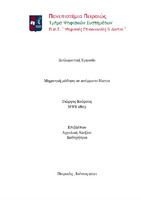Μηχανική μάθηση σε ασύρματα δίκτυα

Προβολή/
Λέξεις κλειδιά
Μηχανική μάθηση ; Ασύρματα δίκτυαΠερίληψη
Η παρούσα εργασία εξετάζει τεχνικές μηχανικής μάθησης με εφαρμογή σε ασύρματα δίκτυα.
Σκοπός της παρούσας εργασίας είναι να παρουσιάσει τις βασικές τεχνικές για μηχανική
μάθηση, καθώς και το πως μπορούν να εφαρμοστούν σε ασύρματες επικοινωνίες. Η μηχανική
μάθηση είναι ένα νέο ανερχόμενο επιστημονικό πεδίο με πολλές εφαρμογές , ενώ η ικανότητα
της να προβλέπει και να λύνει όλα και πιο σύνθετα προβλήματα την έχουν εντάξει σχεδόν σε
κάθε επιστημονικό πεδίο τεχνολογικό ή μη. Από την άλλη , οι ασύρματες επικοινωνίες
αποτελούν πλέον αναπόσπαστο κομμάτι της καθημερινότητας μας έχοντας ως αποτέλεσμα οι
κινητές συσκευές αλλά και οι απαιτήσεις των χρηστών να αυξάνονται συνεχώς. Τα ασύρματα
δίκτυα νέας γενιάς αναμένεται να υποστηρίζουν εξαιρετικά υψηλούς ρυθμούς δεδομένων αλλά
και νέες εφαρμογές οι οποίες θα έχουν υψηλες απαιτήσεις (QOS-quality of service) και θα
φέρουν νέες προκλήσεις στην ασύρματη τεχνολογία. Η δυναμική ανάθεση πόρων και η
συνεχόμενη αλλαγή του ασύρματου καναλιού ήταν ανέκαθεν ένα πεδίο έρευνας. Η πρόκληση
λοιπόν είναι να δημιουργηθεί ένα έξυπνο δίκτυο που θα μαθαίνει και θα προσαρμόζεται στα
δεδομένα αλλά και θα παίρνει αποφάσεις από μόνο του σκοπεύοντας στο καλύτερο QOS του
τελικού χρήστη αλλά και στην καλύτερη αξιοποίηση των πόρων του δικτύου. Η τεχνητή
νοημοσύνη και πιο συγκεκριμένα η μηχανική μάθηση είναι οι καταλληλότερες για την
δημιουργία τέτοιων δικτύων, προσφέροντας την εξυπνάδα που χρειάζονται με ίσως και άριστα
αποτελέσματα. Είναι λοιπόν αναπόφευκτο ότι τα δίκτυα επόμενης γενιά θα υποβοηθούνται
από αυτές τις τεχνολογίες, ενώ όσο οι γνώσεις μας αυξάνονται καλύτερες εφαρμογές θα
δημιουργούνται.
Στο πρώτο κεφάλαιο γίνεται μια εισαγωγή στην μηχανική μάθηση, αναφερόμαστε στα τρία
είδη της, όπου αναλύονται οι βασικές τεχνικές, οι αλγόριθμοι που χρησιμοποιούνται, τα
πλεονεκτήματα αλλά και τα μειονεκτήματά τους. Στο δεύτερο κεφάλαιο αναφερόμαστε σε
υπάρχοντα συστήματα ασύρματων επικοινωνιών δίνοντας τα βασικά χαρακτηριστικά τους. Για
κάθε σύστημα παρουσιάζεται μια μέθοδος μηχανικής μάθησης η οποία προσαρμόζεται στο
εκάστοτε σύστημα ενώ παρουσιάζονται πειραματικά αποτελέσματα που έχουν γίνει
συγκρίνοντας την απόδοση τους με τις ως τώρα παραδοσιακές τεχνικές. Στο τρίτο και τελευταίο
παρουσιάζονται αποτελέσματα από προσομοιώσεις που έγιναν σε python για δυο διαφορετικά
συστήματα δείχνοντας την απόδοση τους.


